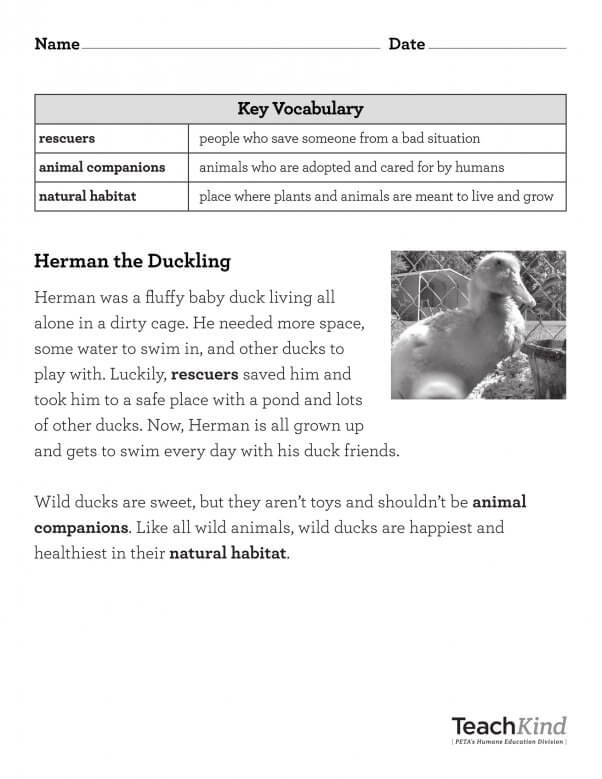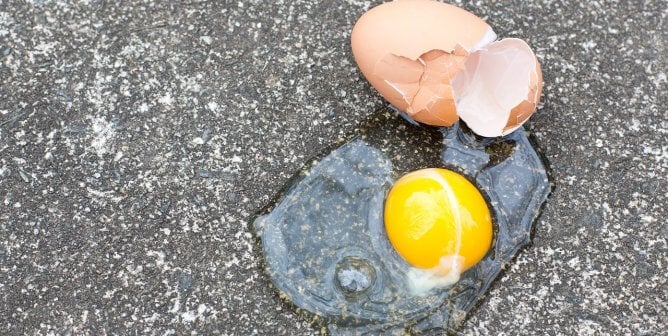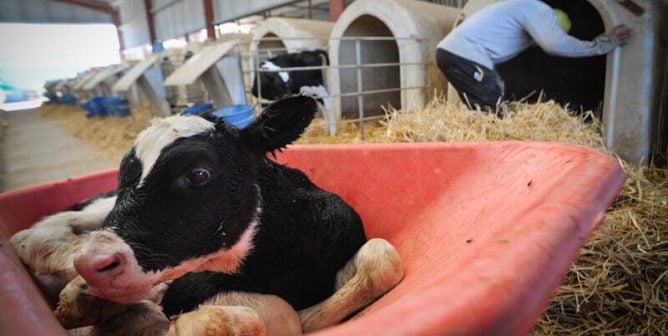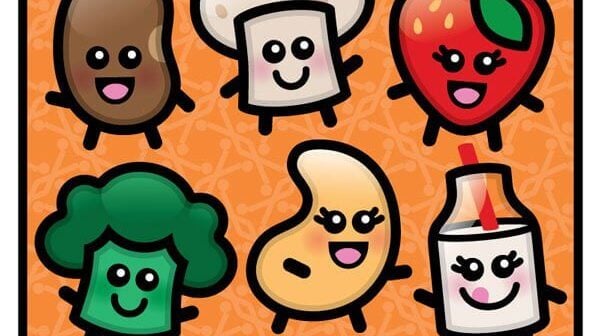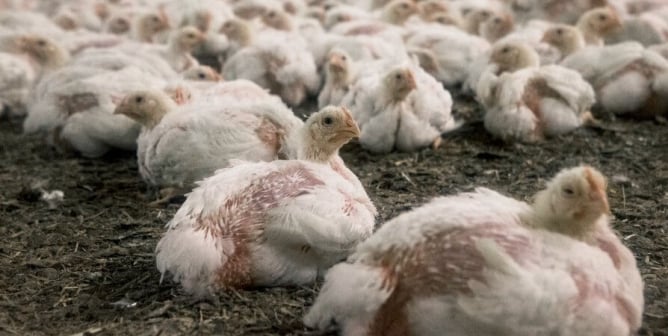What’s Wrong With School Hatching Projects?
When the topic of life cycles is covered in class, teachers try to find activities that will resonate with students. One common classroom demonstration of life cycles involves an incubator and live chicks or ducklings. But what do the babies who hatch into such an unnatural environment endure, and what becomes of them when the class moves on to a new subject? What does it teach children when animals are treated like objects? After the lesson is over, the classroom has a brand-new responsibility: caring for the surviving birds or finding homes for them.
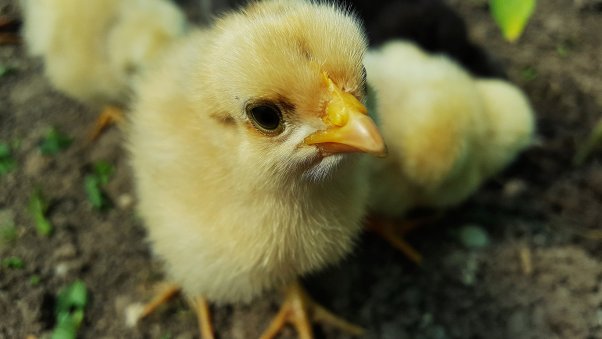
The Suffering of Chicks and Ducklings in Hatching Projects
The best candidate to raise a baby animal is the baby animal’s mother. A mother hen “talks” to her chicks before they hatch, while they’re still inside the shell, to teach them to recognize her voice in a flock. Even experienced rehabilitators who do everything correctly still struggle to keep newly hatched chicks and ducklings alive. As you can imagine, grade school children and their teachers generally can’t provide baby birds with proper care. In fact, the chicks and ducklings used in school projects are often harmed even before they hatch—if the eggs aren’t properly rotated in the incubators, the birds will die inside the shell or end up with terrible deformities. Once hatched, if baby birds aren’t immediately provided with proper nutrition, they will develop an array of painful, debilitating, and life-threatening conditions. And children frequently mishandle vulnerable baby birds. Sadly, many chicks and ducklings hatched in the classroom die there.
What Do Chicks and Ducklings Endure After the Hatching Project Is Over?
There are many possible outcomes for baby birds after a hatching project is over, but most of them are very sad. It’s generally not an option for teachers and students to take them in as animal companions. It’s illegal to keep chickens or ducks in many places. Even in places where they are allowed, these animals require a great deal of work, and have extensive and expensive needs regarding proper food, shelter, and veterinary care. Here are a few common outcomes after a hatching project is over:
- The birds are taken to an open-admission shelter. Domestic ducklings and chicks are not wild animals and can never be released to fend for themselves, so wildlife rehabilitators typically don’t accept them. Traditional animal shelters—already bursting at the seams with dogs and cats—are rarely equipped to care for them, and chicks and ducklings are seldom placed in qualified homes simply because there aren’t very many of them available.
- The birds are taken back to the commercial poultry supplier that provided the eggs. These babies are often immediately slaughtered so that they won’t contaminate commercial flocks with unknown pathogens that they may have picked up at a school.
Note: These commercial suppliers are often factory farms where tens of thousands of birds are crammed into cages so small that they’re unable to spread their wings and forced to live amid their own waste.
- The birds are offered for sale or given away online. There is no shortage of tragic stories of animals who were listed online as “free to a good home.”
- The birds are dumped in the park, on the street, or in other unsuitable environments. Baby birds have even been found in dumpsters and trash cans. (Read on to understand why domestic animals are unable to survive in the wrong environment.)
Meet Two Ducks Who Were Abandoned and Then Rescued in New York
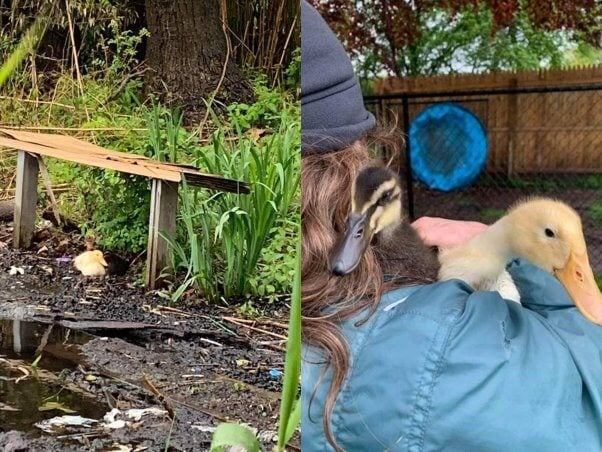
These two domestic ducks were rescued by Long Island Orchestrating for Nature (LION), an animal rescue organization, from a neighborhood pond on Long Island in New York, where they were struggling to survive. Here is their story, told by John Di Leonardo, the founder and president of LION and a senior manager at PETA:
Dougie, a white Pekin duck, had niacin deficiency (which is common in baby ducks who are improperly cared for) when we picked her up, and as a result, her leg turned inward. Although we immediately got her on supplemental nutrition, it was too late. She grew rapidly—much larger and faster than her wild counterparts—and became crippled. She could only walk with the help of a wheelchair and swim with supervision so that she didn’t drown. Given her disability, one of LION’s regular foster homes adopted both her and her buddy, Enzo—a male Rouen. Dougie passed away sitting in her wheelchair about 6 months later, likely from organ failure because she had been malnourished at such a young age. Enzo is still doing well and has chosen another special-needs female Pekin, named Angel, as his mate. Angel has “angel wing,” another disorder resulting from malnutrition (usually from being fed bread). She was rescued after having been abandoned at another Long Island park the same year along with another Pekin—named Miracle—who also had niacin deficiency and also passed away in a wheelchair at a sanctuary.
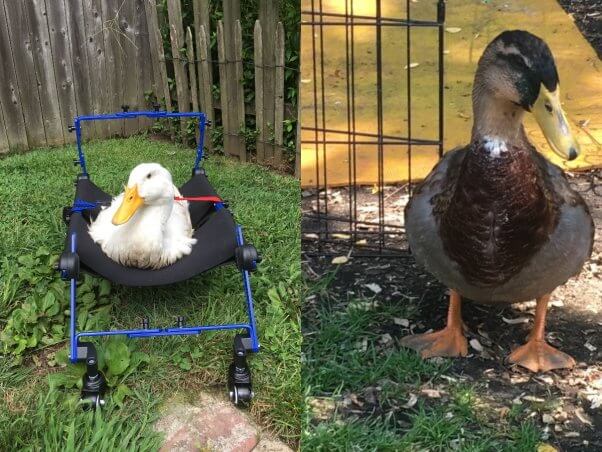
You can read more LION rescue stories here.
Every year, teachers hatch ducks like these two in their classrooms and then abandon them, thinking that they can survive, but this is not the case. Young ducklings are still covered in a down-like “baby fuzz,” and their feathers are not yet waterproof. When dumped into ponds, they become saturated and can even drown. Abandoned ducks don’t have the natural instincts to forage for food and defend themselves from predators—they were raised in incubators by children and not given the opportunity to learn from their mothers. Most importantly, domestic ducks have been bred to have large bodies and small wings, rendering them flightless—so when ponds freeze over in winter, they can’t migrate or fly around in search of open water and food as wild birds do. Most are killed by predators or die of starvation or dehydration, while others become frozen in the ice. Dumping domestic ducks sentences them to a cruel death.
Modern, Humane Alternatives to Hatching Projects
For educational value, hatching projects miss the mark. But there are several free and paid programs that do meet curricular objectives and save baby birds:
- Learning Resources sells a set of 21 egg replicas that show development day by day. TeachKind will donate a free kit to any teacher who pledges to stop hatching chicks in the classroom. If you’re interested in replacing this experiment with humane methods, please e-mail us at [email protected]!
- Virginia Tech’s 4-H Virtual Farm Chicken Embryo Development site includes video footage of chick embryo development, still images, and text on the development process.
- The University of Illinois–Urbana-Champaign’s Chickscope provides diagrams, images, and detailed information on each day of the chicken embryo development process.
- The NOVA Online Odyssey of Life website includes a video clip of chick embryo development.
- Egg: A Photographic Story of Hatching by Robert Burton (with photographs by Jane Burton and Kim Taylor) uses close-up photographs to show the egg-hatching process. The book follows the process from the first crack in the shell to the moment when the chick breaks out of the egg.
- A Home for Henny, written by United Poultry Concerns founder Karen Davis and illustrated by Patricia Vandenbergh, tells the story of a grade-school hatching project and a chick named Henny who would have been disposed of but finds a happy home at a sanctuary, thanks to a student named Melanie and her parents.
- Virtual Incubator guides students through every step of the 21-day chick-hatching process in one sitting. Students are required to monitor the health of the virtual eggs, weigh and rotate them, and check the humidity of the virtual incubator.
TeachKind Rescue Stories: Herman the Duckling’s First Swim (K–2)
Why Chick-Hatching Projects Are Never a Good Idea—Learn More
Children can learn about life cycles without bringing animals into the classroom. Using animals as interactive tools doesn’t foster respect for them—instead, children get the message that they’re ours to do with as we please. Hatching projects also convey the message that it’s OK to separate animals from their families and homes in order to use them for our own purposes. Promote compassion in your students by leaving animals out of the classroom.
*****
Please share this resource to inspire other teachers to incorporate compassion for animals into their curricula.

